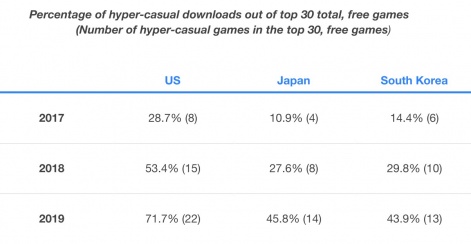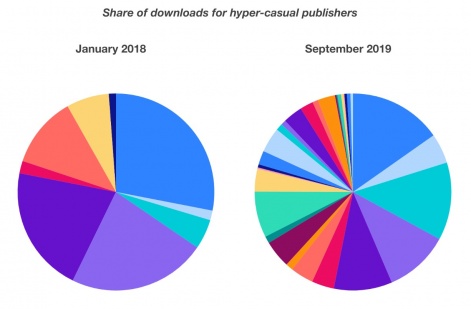This is a guest column from Omer Kaplan, CRO and Co-Founder, ironSource.
At the end of 2018, after a year where hypercasual exploded onto the mobile game market, we attempted to delve into “The truth about hypercasual".
- We explored the size of this market,
- analyzed what’s fueling its growth,
- discussed how it’s impacting the wider industry, and
- asked the golden question of how sustainable the hypercasual market really is?
One year on and hypercasual’s size and impact on the wider industry remains substantial.
It’s time to revisit this still relatively young mobile game genre.
The hypercasual market in numbers
To understand the hypercasual market, it’s important to put it in context of the growth, in size and revenue, of the entire mobile gaming market.
In 2018, the total addressable market of mobile games was $50 billion, of which $10 billion came from in-game advertising and the rest from IAP (in-app purchases).
In 2019 the overall number jumped to $57.6 billion of which $12 billion was from ads, marking a 20% increase in revenue from ads and a 14% increase in revenue from IAP.
Digging deeper into this, IAP revenue is on the rise, with an increase from 11.5% to 14% when comparing 2018 to 2019. However, install growth is slowing down, with a growth of 7.7% in 2018 compared with just 5.3% in 2019.
- Tl:dr - overall mobile game revenue growth is increasing YoY while install growth is declining YoY.
Now let’s look at hypercasual market growth.
Since January, hypercasual games have seen an average of 17.6 million daily installs, which represents 12.5% of total game installs.
Growth-wise, it comes as no surprise that YoY we see a drop, since 2018 was undoubtedly the year that hypercasual exploded onto the scene.
Almost 80% of the install growth in the industry is driven by hypercasual games.
Nevertheless, we do see a significant 37.1% (1.3 billion installs) growth since last year, compared with the 5.3% (1.7 billion installs) growth for the mobile gaming industry as a whole.
This means that hypercasual’s share of install growth in 2019, compared with the entire growth of installs, is a whopping 76.4%.
- Tl:dr - almost 80% of the install growth in the industry is driven by hypercasual games.
Looking at revenue, we combined market information together with insights from within ironSource, to estimate that the size of the hypercasual market is approximately $3 billion a year, a 33% increase from last year’s $2.25 billion.
The bottom line is this - in 2019 hypercasual generated about 5% of the total revenue from mobile games and 12.5% of the installs, but took 38% of the total pie for ad revenue and 76.4% of the install growth.
Critically, hypercasual games represent 40-50% of the total available in-game ad inventory. The significance of the impressions generated cannot be ignored. More on that below.

Why is hypercasual (still) growing so quickly
There are 3 main reasons driving this growth.
The first is that hypercasual is without a doubt a global phenomenon, spreading beyond the markets it originated in. Users are consistently opting for accessible entertainment experiences that can be enjoyed in small bursts in between or simultaneous to other activities, and hypercasual games scratch this itch.
Take a look at Japan as an example. According to App Annie, the number of hypercasual games in the top 30 free games in Japan has rocketed from 4 in 2017, which generated 11% of the installs, to 14 in 2019, which generated almost 50% of the installs. A similar trend can also be seen in South Korea.

The second reason is that IPM (installs per thousand ad impressions) grew a staggering 70% over the past year, which obviously lead to more installs.
Lastly, there are more “players” in the game now. Whereas last year the market was mainly controlled by a few larger companies, the low barriers to entry have increased distribution and diversification in the market with hypercasual seeing many previously unknown, rising stars such as ITI, Moonee and Coda Games making it to the top of the charts.

Market growth vs money flow
Last year we looked at the relative sustainability of the hypercasual market in isolation, concluding that the money coming in from non-hypercasual advertisers (in this case primarily IAP-based games and brand advertisers) was critical to the sustainability of the hypercasual market, pumping in the money which effectively subsidizes the category.
This year we’ve seen a YoY growth of 52.4% in non-hypercasual advertisers buying on hypercasual supply.
Once again, the money from IAP-based games and brands sustains the hypercasual market, but equally what has emerged is that IAP-based games and brands are in turn reliant on hypercasual games to continuously expand the available pool of ad inventory.
The distribution between hypercasual and non-hypercasual advertisers’ spending on hypercasual inventory is currently a 70/30 split respectively.
Were non-hypercasual advertisers to increase their share of the pie and drive up CPIs, they might price out hypercasual advertisers, eventually leading to a drop in DAU and a decline in the inventory pool overall.
Yet continuing to grow IAP-based games is what sustains the actual mobile game economy. The balance is a delicate one and it will be interesting to see how the market would react to a shift in distribution in either direction.
What’s in store for hypercasual?
Looking ahead, it’s likely we’ve seen the end of the hyper-growth in hypercasual installs, which has passed the initial growth spurt that a new category enjoys as it launches and as creators race to get their slice of the cake.
It’s likely we’ve seen the end of the hyper-growth in hypercasual installs.
On the positive side, we think it’s likely that revenue in this market will continue to grow at a similar rate to this year. A predicted 30% growth will result from better, more complex games with higher retention rates, and technological advancements from the gametech companies that support mobile game growth.
Beyond the numbers, we’re also likely to see a number of shifts in the market as the category matures.
- IPM growth will stabilize
2019 saw an impressive growth in IPM due to both increased creativity and optimization, and a slew of aggressive tactics in ad creatives, from click-to-store mechanisms, to deceptive ads misrepresenting gameplay. While it might have lead to a spike in installs, these tactics are ultimately unsustainable, and are ruining the trust of users. Moving forward into 2020, the IPM average will drop to a more realistic figure, which will obviously affect the quality of installs for all ‘players’ in the market.
- Downward margin pressure will change the publishing model
The competitive market we covered above results in reducing the margins for each of the players, provoking a race to the bottom. This can affect the overall sustainability of the market. Downward margin pressure may also lead publishers to develop in-house, as opposed to sharing revenue with a developer, leaving more of the smaller studios to publish independently. While this isn’t an end to publishing as we know it, it is a trend which we see continuing to gain traction.
- Cloning will [hopefully] force greater innovation
And finally, ideas for games are running out. Every new game concept quickly develops multiple clones. Has creative innovation in hypercasual reached its peak or will saturation force creativity on a totally new level?
Finally, hypercasual has and will continue to be its own category. It’s not a one-hit-wonder. It’s here to stay. The question now is which category will take the limelight next year?























